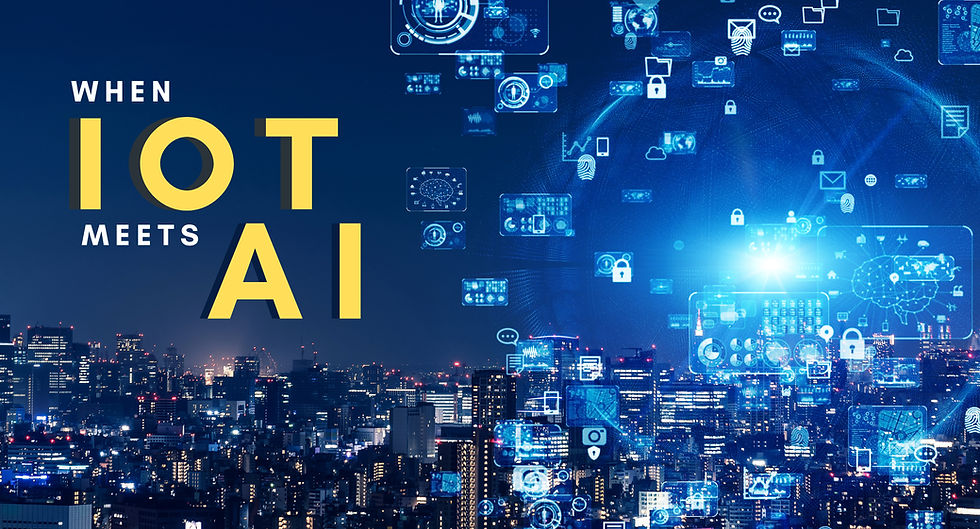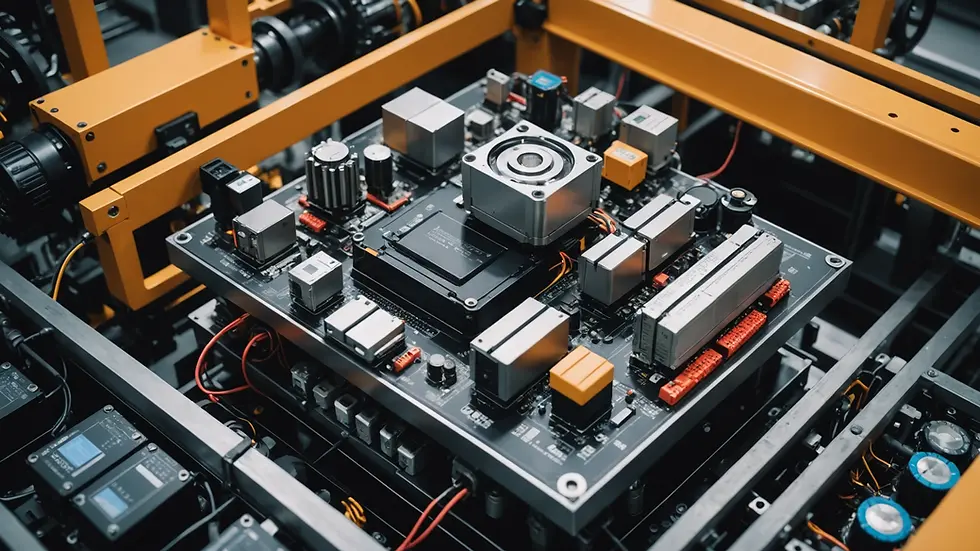IoT Meets AI: How Predictive Intelligence is Revolutionizing Utility Management in Manufacturing
- Sohel Hussain
- 6 days ago
- 6 min read

The world is moving toward intelligence-driven operations, and at the heart of this shift lies the fusion of the Internet of Things (IoT) with Artificial Intelligence (AI). This convergence, often called the s (AIoT), is Artificial Intelligence of Thing transforming how we sense, analyze, and act in real time.
Instead of passively observing events, businesses can now predict, decide, and execute actions within seconds. This transformation is particularly visible in manufacturing, where efficiency, uptime, and precision directly affect competitiveness. Watch on youtube
From Observation to Intelligent Action_(IOT)
At its core, IoT is about sensing, while AI is about thinking. A simple IoT setup may capture the temperature of a machine and report “95°C.” But when IoT is coupled with AI, that same system recognizes patterns from past operations and predicts what is likely to happen:
“Based on current and historical data, this machine may overheat in the next fifteen minutes; reduce the load now.”
That is the leap from observation to intelligent action.
Smart Sensors: The Heart of AIoT
Smart sensors sit at the center of this transformation. They are no longer just passive devices that collect raw signals.
Today’s sensors filter noise, preprocess data at the edge, and transmit only the most relevant features to AI systems in the cloud or on local gateways. This makes decision-making faster and more efficient.
For example, in autonomous vehicles, LiDAR and radar sensors do not stream billions of data points to a server. Instead, they preprocess and feed AI systems with the information they need shapes, distances, and velocity. The same principle applies to factories, hospitals, and smart cities.
The Four Stages: From Sensing to Action
The journey from sensing to action unfolds in four broad steps:
Data Capture – Sensors collect information such as vibration, pressure, or sound.
Edge Preprocessing – Unnecessary noise is filtered and summarized before transmission.
AI Inference – Algorithms detect anomalies, predict failures, or suggest optimizations.
Decision Execution – The system triggers an action, from a simple alert to an automated adjustment on the production line.
Example: Predictive Maintenance in Manufacturing
To bring this alive, consider a manufacturing plant producing automotive engines.
On the assembly line, vibration sensors monitor high-speed drilling machines. Instead of streaming raw signals, the sensors calculate average amplitudes and detect abnormal spikes.
An AI model trained on years of data recognizes these spikes as early signs of bearing failure. It predicts with ninety percent confidence that the spindle may break down within the next seventy-two hours.
Based on this, the system automatically schedules maintenance during the next low-production window, avoiding unplanned downtime and saving thousands of dollars in emergency repairs.
This is not hypothetical—it’s how predictive maintenance works on smart factory floors today.
AI in Quality Inspection
Another powerful example comes from quality inspection in tire manufacturing. Every tire rolling off the line is scanned using high-resolution cameras and IoT-connected image sensors.
Instead of relying on human eyes alone, AI models process these images in real time to detect micro-defects such as surface cracks, bulges, or air bubbles that may compromise safety.
As soon as a flaw is detected, the system diverts the tire for rework.
Over time, the AI system not only identifies defects but also learns which process conditions or material batches tend to produce them, allowing managers to refine operations upstream and reduce defect rates altogether. Watch on youtube
Beyond Maintenance: Smarter Ecosystems
These workflows illustrate how IoT and AI transform factories from reactive environments to proactive and predictive ecosystems.
The benefits, however, extend well beyond maintenance and inspection.
In steel plants, thermal sensors embedded in furnaces monitor heat distribution and alert AI models to uneven patterns. The system then adjusts airflow to prevent accidents and optimize energy usage.
In FMCG packaging plants, torque sensors on robotic arms track the load handled during each cycle. AI models interpret this data to predict misalignment or wear, prompting recalibration before inefficiencies or breakdowns occur.
Each example reinforces the central truth: smart sensors supply the eyes and ears, while AI serves as the brain making sense of it all.
AIoT in Energy Management
The impact is not limited to the factory floor. Energy management is another critical area.
Manufacturing is notoriously energy-intensive, and small inefficiencies compound into massive costs.
IoT-enabled smart meters track consumption across machines, HVAC systems, and lighting. Instead of just reporting monthly usage, AI detects patterns, such as a CNC machine consuming far more energy at night than during the day.
This insight may reveal calibration issues or operator-driven inefficiencies. With AIoT, factories can optimize energy use, cut costs, and even reduce their carbon footprint—an increasingly important competitive advantage.
A Day in the Life of a Smart Automotive Factory
At 8:00 AM, production begins in an automotive plant manufacturing engines. As the conveyor belts move into action, sensors on the assembly line start streaming data on vibration, torque, and temperature.
By 8:15, the AI dashboard alerts supervisors that one of the robotic arms assembling crankshafts is showing torque variations outside the normal range. Without AIoT, this anomaly might go unnoticed until a batch of defective assemblies was discovered at the end of the shift. Instead, the system immediately recalibrates the robot, saving both time and materials.
By 11:00 AM, thermal cameras on the paint shop floor flag uneven heat distribution in the curing ovens. The AI system identifies blocked airflow vents as the cause and automatically adjusts the fans to restore uniform heating. Without intervention, this would have led to uneven paint jobs, rework, and higher energy usage.
After lunch, the quality control unit runs high-speed imaging on newly assembled engines. An AI model picks up microscopic surface defects on a small batch of engine blocks. The system isolates the batch, triggers an automated report, and cross-references it with supplier data. Within minutes, managers learn that the faulty batch originated from a particular casting machine, which is then flagged for inspection.
By 6:00 PM, as production winds down, the plant’s AI-driven energy management system analyzes the day’s power usage. It notes that one set of CNC machines consumed significantly more electricity than the rest and suggests an off-peak operational schedule to balance loads and reduce energy bills by nearly 12%.
In this factory, sensors never sleep, and AI never blinks. Together, they ensure production remains not just efficient but resilient, sustainable, and future-ready. Watch on youtube
Challenges Ahead
As powerful as these examples are, challenges remain. Factories must balance how much computation happens at the edge versus in the cloud.
Sensitive production data requires strong security measures. Scaling systems across multiple plants introduces complexity. And AI models require retraining to remain accurate as new equipment or processes come online.
Yet, these are solvable challenges, and manufacturers that address them today are positioning themselves for long-term leadership.
The Future of AIoT: What’s Next
The future of AIoT in manufacturing is even more exciting. With TinyML, machine learning will run directly inside sensors, making them truly autonomous.
5G networks will enable sensors and machines to communicate with near-zero latency, unlocking possibilities like fully autonomous production lines.
Federated learning will allow AI models to be trained across global plants without moving raw data, preserving confidentiality while improving intelligence.
The vision is a self-healing factory—where machines diagnose themselves, order spare parts, and schedule repairs automatically.
Avizops: Powering the Future of Smart Manufacturing
At the forefront of this transformation stands Avizops Solutions, pioneering the integration of AI and IoT to build cognitive, self-aware manufacturing ecosystems.
With solutions like CAQA™ (Cognitive AI-Based Quality Analyst) and advanced Digital Twin technology, Avizops empowers industries to go beyond monitoring — enabling real-time insight, predictive intelligence, and autonomous decision-making.
By bridging data from sensors, machines, and enterprise systems, Avizops delivers a unified intelligence layer that drives efficiency, reliability, and sustainability.
From predictive maintenance to defect detection and process optimization, Avizops is not just adapting to Industry 4.0 — it’s engineering the foundation of Industry 5.0, where humans and intelligent systems collaborate seamlessly to build the factories of the future. www.aizops.com
Conclusion: The Intelligence Revolution
In conclusion, IoT and AI together are redefining the DNA of manufacturing.
They are not just about gathering data but about creating intelligence at the edge of operations.
From predictive maintenance that prevents costly downtime, to quality inspection that ensures real-time compliance, to energy optimization that directly improves margins—the benefits are clear and measurable.
The factories of tomorrow will not wait for problems; they will predict, adapt, and respond instantly, thanks to the power of smart sensors fueling AI-driven decisions. Watch on youtube






Comments